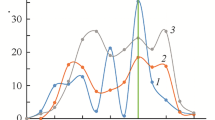Abstract
Characteristics of a thunderstorm cloud, from which a waterspout over Ladoga Lake appeared are studied with the use of the measurements from C-band Doppler Meteorological Radar (DMRL-C), a lightning detection system, and a high-altitude atmospheric radiosonde. Analysis of the indices of convective instability showed small to moderate probability of the development of intense convective processes. We applied algorithms for hydrometeor classification and updraft determination from DMRL-C measurements of polarization characteristics for the first time. These algorithms revealed the occurrence of large ice particles in the cloud at the beginning of thunderstorm activity and recorded an extended updraft associated with the waterspout. Analysis of dependences between the lightning frequency and different radar characteristics showed that the correlation is the strongest with a number of large ice particles characterized by the volume of supercooled (above 0°C isotherm) part of the cloud with reflectivity larger than 50 dBZ.



Similar content being viewed by others
REFERENCES
A. I. Bedritskii, Russian Hydrometeorological Dictionary (Letnii sad, St. Petersburg, 2009) [in Russian].
H. S. Park, A. V. Ryzhkov, D. S. Zrnic, and K.-E. Kim, “The hydrometeor classification algorithm for the polarimetric WSR-88D: Description and application to an MCS,” Weather Forecast 24, 730–748 (2009).
B. Dolan and S. A. Rutledge, “A theory-based hydrometeor identification algorithm for X-band polarimetric radars,” J. Atmos. Ocean. Technol. 26, 2071–2088 (2009).
B. Dolan, S. A. Rutledge, S. Lim, V. Chandrasekar, and M. Thurai, “A robust C-band hydrometeor identification algorithm and application to a long-term polarimetric radar dataset,” J. Appl. Meteorol. Climatol 52, 2162–2186 (2013).
A. V. Ryzhkov and D. S. Zrnic, Radar Polarimetry for Weather Observations (Switzerland, Springer, 2019).
T. J. Carlin, J. Gao, J. C. Snyder, and A. V. Ryzhkov, “Assimilation of ZDR Columns for Improving the spinup and forecast of convective storms in storm-scale models: Proof-of-concept experiments,” Mon. Weather. Rev. 145, 5033–5057 (2017).
A. A. Sin’kevich and Yu. A. Dovgalyuk, “Corona discharge in clouds,” Radiophys. Qunatum Electron. 56 (11-12), 818–828 (2014).
V. B. Popov, A. A. Sin’kevich, Dzh. Yang, Yu. P. Mikhailovskii, M. L. Toropova, Yu. A. Dovgalyuk, N. E. Veremei, and D. S. Starykh, “Characteristics and structure of cumulonimbus clouds in a water spout in the North-Western Region of Russia,” Rus. Meteorol. Hydrol. (in print).
D. M. Lal and S. D. Pawar, “Relationship between rainfall and lightning over Central Indian Region in monsoon and premonsoon seasons,” Atmos. Res. 92, 402-410 (2009).
A. Karagiannidis, K. Lagouvardos, S. Lykoudis, V. Kotroni, T. Giannaros, and H.-D. Betz, “Modeling lightning density using cloud top parameters,” Atm-os. Res. 222, 163–171 (2019).
A. T. Pessi and S. Businger, “Relationships among lightning, precipitation, and hydrometeor characteristics over the North Pacific Ocean,” J. Appl. Meteorol. Climatol. 48 (4), 833–848 (2009).
V. N. Stasenko, Radar Study of Multicell Convection (Thunderstorm) Clouds (Gidrometeoizdat, St. Petersburg, 2004) [in Russian].
V. D. Stepanenko, Radar Positioning in Meteorology (Radio Meteorology) (Gidrometeoizdat, Leningrad, 1973) [in Russian].
Yu. P. Mikhailovskii, A. A. Sin’kevich, S. D. Pavar, V. Gopalakrishnan, Yu. A. Dovgalyuk, N. E. Veremei, E. V. Bogdanov, A. B. Kurov, A. Kh. Adzhiev, A. M. Malkarova, and A. M. Abshaev, “Investigations of the development of thunderstorm with hail. Part 2. Analysis of methods for the forecast and diagnosis of the electrical properties of clouds,” Rus. Meteorol. Hydrol. 42 (6), 377–387 (2017).
E. Wanke, R. Andersen, and T. Volgnandt, http://en. blitzortung.org/Compendium/Documentations/Documentation_2014-05-11_Red_PCB_10.4_PCB_12.3_ PCB_13.1_PCB_14.1.pdf. Cited January 13, 2020.
R. W. Armstrong and J. G. Glenn, “Electrical role for severe storm tornadogenesis (and modification),” J. Climatol. Weather Forecast 3 (3), 1–8 (2015).
M. S. Stough, L. D. Carey, and C. J. Schultz, “Total lightning as an indicator of mesocyclone behavior,” in Proc. of the XV Int. Conf. Atmos. Electr. Norman, Oklahoma, June, 15–20,2014. P. 1–15.
A. A. Sin’kevich, Yu. P. Mikhailovskii, Yu. A. Dovgalyuk, N. E. Veremei, E. V. Bogdanov, A. H. Adzhiev, A. M. Malkarova, and A. M. Abshaev, “Investigations of the development of thunderstorm with hail. Part 1. Cloud development and formation of electric discharges,” Rus. Meteorol. Hydrol. 41 (9), 610–619 (2016).
A. A. Sin’kevich, Yu. P. Mihajlovskii, S. Yu. Matrosov, V. B. Popov, V. S. Snegurov, A. V. Snegurov, Yu. A. Dovgalyuk, and N. E. Veremei, “Relationships between the structure of convective clouds and lightning frequency derived from radiophysical measurements,” Rus. Meteorol. Hydrol. 44 (6), 394–403 (2019).
ACKNOWLEDGMENTS
The authors thank S. Egorchenko, who took a photo of waterspout, provided access to it, and permitted us to use it in our study (https://vk.com/sergey_eg?w=wall1471346_ 2750%2Fall).
Funding
This work was supported by the Russian Foundation for Basic Research (under grants no. 17-05-00965_a and BRIKS_t no. 18-55-80 020).
Author information
Authors and Affiliations
Corresponding author
Ethics declarations
The authors declare that they have no conflicts of interest.
Additional information
Translated by O. Bazhenov
Rights and permissions
About this article
Cite this article
Sin’kevich, A.A., Popov, V.B., Mikhailovskii, Y.P. et al. Characteristics of Cumulonimbus with Waterspout over Ladoga Lake from Remote Measurements. Atmos Ocean Opt 33, 387–392 (2020). https://doi.org/10.1134/S1024856020040156
Received:
Revised:
Accepted:
Published:
Issue Date:
DOI: https://doi.org/10.1134/S1024856020040156




